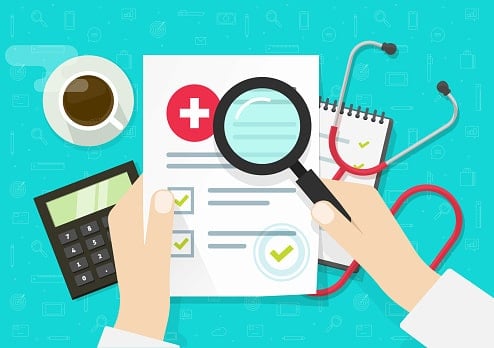- How to find affordable health insurance
- Individual and Affordable Care Act (ACA) plans
- Catastrophic health plans: What they cover, who qualifies
- Medicaid: Income-based government health insurance
- Short-term health plans for temporary coverage
- Health insurance through your employer
- How do I get cheap health insurance?
How to find affordable health insurance
The cost of health insurance is a combination of monthly premiums and out-of-pocket costs when you use your coverage. The more you're willing to pay out of pocket for care, the lower those monthly rates will be. But not all healthcare needs can be predicted, so it's hard to guess how much you'll pay for care throughout the year.
That means the most inexpensive health insurance plans for monthly premiums are those with higher deductibles, coinsurance, and copayments. That makes shopping for affordable healthcare a balancing act between what you pay monthly and what you must pay if you need care.
Fortunately, there are programs and plans to make affordable health insurance accessible.
Individual and Affordable Care Act (ACA) plans
Individual health plans are available in the ACA marketplace and outside the marketplace.
The ACA exchanges are designed to help people find the most affordable health insurance plan available while ensuring basic coverage. ACA plans:
- Must meet specified criteria, covering ten essential health benefits, including prescription drugs, outpatient, hospitalization, and mental health
- Can't deny you coverage or increase your rates based on a pre-existing condition
ACA healthcare subsidies to reduce insurance rates
The federal government offers low-income health insurance tax credits and subsidies. If your household income is between 100% and 400% of the federal poverty level, you are likely eligible for subsidies to make ACA health insurance cheaper. That’s about $12,880 to $51,520 for an individual and $26,500 to $106,000 for a family of four.
"Many uninsured individuals are eligible for generous subsidies but either don't realize it or do not take advantage of them," Dr. Kevin Griffith, an assistant professor at Vanderbilt University's Department of Health Policy says.
You'll be asked to submit your household income information when shopping on the ACA exchange website. The tool provides subsidies where appropriate, so you’ll know what to expect to pay in premiums.
Expert Advice

Kevin Griffith
Assistant Professor, Department of Health Policy, Vanderbilt University, Nashville, TN
“Many uninsured individuals are eligible for generous subsidies, but either don't realize it or do not take advantage of them.”
ACA marketplace metal tiers
There are four main tiers of ACA plan:
- Bronze
- Silver
- Gold
- Platinum
The most affordable health insurance in the ACA marketplace in terms of premiums are Bronze plans, except for catastrophic plans, discussed below.
- A Bronze plan generally costs less initially but requires more out-of-pocket expenses than the other plans for healthcare services. According to the Kaiser Family Foundation (KFF), the lowest-cost Bronze plan in 2025 averages $381 a month.
- Platinum plans have the highest premiums but the lowest out-of-pocket costs and deductibles.
- Silver plans typically have higher premiums than Bronze. However, if you qualify for subsidies, you may find a Silver plan that's cheaper than a Bronze plan. A Silver plan has lower out-of-pocket costs than a Bronze plan. So, a Silver plan might be a better bet if you qualify for subsidies. The KFF reports an average monthly cost of $486 a month for the lowest-cost Silver plan.
However, if you don't qualify for subsidies, ACA plans can be more expensive than an employer-sponsored plan. In that case, you may want to look for an individual plan outside of the marketplace. Plans outside of the exchanges don't have as many requirements and can be more affordable than ACA plans.
You can look for an individual plan outside of the exchanges by checking with an independent health insurance broker or going directly to area health insurers.
If you shop for a plan outside of the exchanges, check the coverage so you know what to expect before signing up.
Step-by-step guide to getting an ACA plan
- Visit healthcare.gov, which is the ACA exchange’s website. The site asks you to enter information such as where you live and your family income. With that information, the tool provides health plan options and premium estimates.
- Choose an HMO over a PPO. HMOs are cheaper but offer the same coverage. However, HMOs require referrals to see specialists, and you can only see doctors in the HMO's network.
- A Bronze plan can be the better choice if you don't expect to need to see a doctor often over the next year.
- If you qualify for subsidies, a Silver plan can wind up costing as little as a Bronze plan but has lower out-of-pocket costs.
- If you can't find an affordable plan on the exchanges, check with individual health insurers in your area for options outside of the exchanges.
Catastrophic health plans: What they cover, who qualifies
Catastrophic health insurance offers low-cost premiums with the comprehensive coverage found in standard health insurance. Catastrophic plans cover preventive care, pregnancy, mental health, prescription drugs, rehab, labs, and outpatient and inpatient care. These plans are limited to people under 30 or facing specific hardships such as homelessness.
Catastrophic plans are available through the Affordable Care Act marketplace. The plans have low premiums but high deductibles. The average monthly premium is only $195, much cheaper than other plans.
However, the deductible is around $8,000. You have to pay for healthcare services until you reach your deductible, at which point the plan pays for all your healthcare costs. Catastrophic health insurance doesn't have a coinsurance portion, which differs from many other plans.
How to get a catastrophic health plan
- Visit your state's ACA marketplace. If you're under 30, catastrophic health insurance should appear as an option.
- If you're facing a hardship, contact your state's marketplace directly and provide information.
Medicaid: Income-based government health insurance
Medicaid is a low-cost health insurance plan with the same benefits as an employer-sponsored health plan.
Depending on your income, you pay little to nothing for Medicaid if you're eligible. The combination of low costs and comprehensive benefits makes Medicaid an excellent, affordable health insurance choice for those who qualify.
Medicaid premiums are based on income, which varies by state. Thirty-eight states expanded Medicaid eligibility to up to 138% of the federal poverty level. That's $17,609 for an individual and $36,156 for a family of four. The other 12 states have stricter eligibility guidelines.
One drawback is that not all providers accept Medicaid, so you may encounter issues finding a doctor who accepts Medicaid.
How to get Medicaid
- Check with your state's Medicaid program. The state program can figure out whether you're eligible and provide options.
- States usually don't offer a choice for Medicaid. Instead, you enroll in the state Medicaid program or a managed Medicaid plan, which is a private insurer that contracts with the state.
Short-term health plans for temporary coverage
Another cheap health insurance option for most Americans is a short-term health plan. You can likely find a short-term health plan for much lower premiums than an employer-sponsored or individual health plan.
Griffith cautions that you should look beyond price before choosing this kind of plan: "Short-term plans generally cost less than traditional insurance plans, but they are exempt from many of the ACA's consumer protections. Unlike traditional insurance plans, short-term plans do not need to cover pre-existing conditions, essential health benefits, and may have lifetime and annual benefit limits."
However, these plans aren't technically considered health insurance.
- They provide coverage for a short period and don't have the same level of benefits you usually find in a health insurance plan.
- Short-term health plans usually don't cover maternity, prescription drugs or mental healthcare.
- They also have annual coverage caps and you must pay all the costs once you reach it.
Short-term health plans are available for one year and most states let you renew them twice. California, Hawaii, Massachusetts, New Jersey and New York don't allow short-term plans. Colorado, Delaware, the District of Columbia, Illinois, Maryland, New Mexico, Vermont and Washington limit the plan's length.
Short-term health plans can help you in between jobs or until a new employer starts covering you. These plans aren't meant as long-term health coverage.
How to find short-term health insurance
- A Google search provides you with insurers that offer short-term health plans.
- Pore over the fine print to understand what the plan covers and what it doesn't.
Health insurance through your employer
Most working-age Americans get their health insurance through an employer.
A benefit of employer-sponsored health insurance is that your job helps pay for coverage. The KFF estimates employers, on average, pay 83% of health insurance costs in a single plan, and the employee picks up 17%. On average, employers pay 72% of health plan costs in a family plan and employees absorb 28%.
The average annual cost of health insurance through an employer in 2024 is $8,431 for single coverage and $23,968 for a family.
The downside of employer-sponsored plans is that you're limited to what your job offers and may only give you one option. Businesses increasingly look for ways to cut healthcare costs and one way is to limit health insurance to a single, high-deductible health plan.
High-deductible health plans (HDHPs) have a deductible of at least $1,400 for individuals and $2,800 for families by federal law.
A deductible is the amount you pay for eligible healthcare services or medications before your insurance plan begins to share the cost. Once you reach your deductible limit, the health plan begins to pay for healthcare after you pay for your coinsurance amount.
HDHPs are often the cheapest employer-sponsored health insurance plans in terms of premiums but have significant deductibles and out-of-pocket costs if you need healthcare services. They also come with health savings accounts (HSA) that allow you to put aside pre-tax dollars for later medical expenses.
How to get employer-sponsored health insurance
- Check with your employer and spouse's employer to review health insurance offerings. You can sign up or make changes to your health insurance during open enrollment, or in case of an approved change in life circumstances. Open enrollment varies by employer.
- You may want to consider a health maintenance organization (HMO) plan rather than a preferred provider organization (PPO) plan for a more affordable option. HMOs have lower premiums than PPOs and similar deductibles. One downside of HMOs is that they have restricted provider networks, so you can only see providers in that network. Plus, you must get referrals from your primary care provider to see specialists. However, that trade-off means you may pay half the premiums found in PPOs.
- An HDHP could be a wise choice if you don't expect to need much healthcare over the next year. HDHPs have lower premiums but higher out-of-pocket costs than HMOs and PPOs. HDHPs also may have health savings accounts that let you save tax-free money for your healthcare. Find out more about the differences between health plans.
- Check each plan's premiums, copays, deductibles and coinsurance, which is the percentage you'll pay for healthcare services once you reach your deductible. Those numbers give you an idea of which plan is most affordable for you.
Health insurance finder tool

COBRA
Learn more about COBRA
How much is your annual household income?
How many members are in your household?
Medicare
Medicare costs vary depending on which option you choose.
Learn more about Medicare costs.
Medicaid

Parent's employer-sponsored health insurance

Spouse's employer-sponsored health insurance

Employer-sponsored health insurance

Preferred-provider Organization (PPOs)
Preferred-provider organization (PPOs) plans are the most common type of
employer-based health plan. PPOs have higher premiums than HMOs and HDHPs, but
those added costs offer you flexibility. A PPO allows you to get care anywhere
and without primary care provider referrals. You may have to pay more to get
out-of-network care, but a PPO will pick up a portion of the costs.
Find out more about the differences between plansHealth maintenance organization (HMO)
Health maintenance organization (HMO) plans have lower premiums than PPOs.
However, HMOs have more restrictions. HMOs don't allow you to get care outside
of your provider network. If you get out-of-network care, you'll likely have to
pay for all of it. HMOs also require you to get primary care provider referrals
to see specialists.
Find out more about the differences between plansHigh-deductible health plans (HDHPs)
High-deductible health plans (HDHPs) have become more common as employers look
to reduce their health costs. HDHPs have lower premiums than PPOs and HMOs, but
much higher deductibles. A deductible is what you have to pay for health care
services before your health plan chips in money. Once you reach your deductible,
the health plan pays a portion and you pay your share, which is called
coinsurance.
Find out more about the differences between plansExclusive provider organization (EPO)
Exclusive provider organization (EPO) plans offer the flexibility of a PPO with
the restricted network found in an HMO. EPOs don't require that members get a
referral to see a specialist. In that way, it's similar to a PPO. However, an
EPO requires in-network care, which is like an HMO.
Find out more about the differences between plans
Learn more about individual insurance plans
How do I get cheap health insurance?
Regardless of how you shop for an affordable health insurance plan, you'll want to examine the numbers and make sure your doctors accept the plan. Otherwise, you may have to pay more or all of the costs for visits to those doctors.
- Compare the premiums, copays, deductibles and out-of-pocket costs.
- Determine what costs are most important.
- Ask yourself if you'd prefer lower premiums or lower out-of-pocket costs.
Michael Daugherty, vice president of sales at GetInsured, advises that very low-premium plans can have higher price tags because of out-of-pocket costs.
"Purchasing a plan with a low premium can be a pitfall if it ends up having a high deductible,” he says. “Also, short-term plans may appear to be cheap, but they only cover you in a catastrophic situation and generally exclude expenses that may result from pre-existing conditions. It's important to buy health insurance from a reputable, qualified broker who can explain your options and tell you what the real cost of a health insurance plan is."
Deborah Gordon, author of "The Healthcare Consumer's Manifesto: How to Get the Most for Your Money," says the best plan depends on your specific circumstances.
"If you don't expect to need a lot of healthcare services, that trade-off may work out well for you,” Gordon explains “But, if you're worried about unanticipated expenses or wouldn't be able to handle medical bills, consider a plan that protects you a little better."
Sources:
KFF. "Average Marketplace Premiums by Metal Tier Accessed August 2025
Business.com. "Healthcare Employer and Employee Costs in 2025." Accessed August 2025












